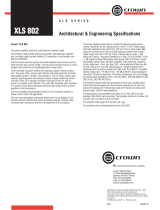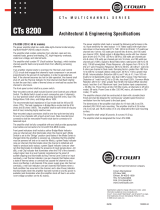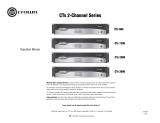Page is loading ...

CTs 4200 USP/CN Architectural & Engineering Specifi cations
CTs MULTICHANNEL SERIES
CTs 4200 USP/CN (120 V, 60 Hz models)
The Crown® power amplifi er shall be a solid-state four-channel model
employing Multi-Mode® (AB+B) output circuitry.
The amplifi er shall contain a 3rd generation DSP-based PIP™ (Program-
mable Input Processor) module, which shall connect the amplifi er to a
100 Mbps Ethernet network, allowing it to be remotely controlled and
monitored via System Architect™ software. In addition, the input module
shall allow the transport of real-time digital audio via CobraNet™ over the
same Ethernet network.
The input module’s processors shall provide digital signal processing.
Audio routing, faders, meters, polarity & mute, input compressors, fi lters,
delays, multimode output limiters, error reporting, and load monitoring
shall be available. A built in noise generator and sine-wave generator pro-
vide noise shall provide masking and test capabilities. The enhanced AUX
port capability shall allow the user to interface with the amplifi er to provide
external manual control and monitoring.
This amplifi er shall require Harman Pro System Architect software, avail-
able from www.crownaudio/forums.
Amplifi er Specifi cations
The amplifi er shall contain protection from shorted, open and mismatched
loads, general overheating, DC, high-frequency overloads, under/over volt-
age, and internal faults.
The amplifi er shall contain FIT (Fault Isolation Toopology), which isolates
channel-specifi c faults and prevents them from affecting remaining chan-
nels.
If an amplifi er channel starts to overheat, the Thermal Level Control (TLC)
circuit shall engage that channel’s input compressor in an amount propor-
tional to the amount of overheating, in order to generate less heat. If the
channel becomes too hot for safe operation, the channel shall shut off,
and the Thermal Indicator for that channel shall fl ash brightly to alert the
user that a state of thermal stress or overload has caused the channel to
shut down.
The front-panel control shall be a power switch.
Rear-mounted controls shall include Channel Level Controls and a Mode
Switch. The Mode Switch (used on each consecutive pair of channels)
is a four-position switch which selects among Dual 8/4 ohms, Dual 70V,
Bridge-Mono 16/8 ohms, and Bridge-Mono 100V.
The recommended load impedance in Dual mode shall be 4/8 and 25 ohms
(70V). The load impedance in Bridge-Mono mode shall be 8/16 ohms and
50 ohms (100V). The amplifi er shall be safe when driving any kind of load,
including highly reactive ones.
Rear-mounted output connectors shall be one four-pole terminal strip for
every two channels with a touch-proof cover. Rear-mounted input con-
nectors shall be removable Phoenix-style barrier connectors for balanced
input.
Front panel indicators shall include a yellow Bridge-Mode Indicator (one
per channel pair) that illuminates when the channel pair’s Mode Switch is
set to the “Bridge” position (and fl ashes if the Mode Switch is changed
while the amplifi er is powered up, indicating that the amplifi er must be
powered off and on to reset the Mode), a green Ready Indicator (one per
channel) that illuminates when the channel is initialized and ready to pro-
duce audio output, a green Signal Indicator (one per channel) that illumi-
nates to indicate the presence of analog input signals above -40 dBu, a red
Clip Indicator that illuminates when the THD of the channel’s output signal
rises to a level typically considered as the onset of audible clipping (and
illuminates during Thermal Level Control or input overload), a red Thermal
Indicator (one per channel) that fl ashes when a state of thermal stress or
overload has caused the channel to shut down (and fl ashes in all channels
if the power supply goes into thermal overload), a red Fault Indicator (one
per channel) that fl ashes when a fault condition has occurred in the chan-
nel, a yellow Data Indicator that fl ashes whenever a command addressed
to the module is received, and a blue Power Indicator that illuminates when
the amplifi er has been turned on and AC power is available (and illuminates
when the amplifi er shuts off due to an under-/over-voltage condition on the
AC mains).
The power amplifi er shall meet or exceed the following performance crite-
ria. Input sensitivity for rated output: 1.4 V. Rated output with four chan-
nels driven in Dual mode with 0.1% THD (20 Hz to 20 kHz): 260 watts per
channel into 4 ohms; 180 watts per channel into 8 ohms, and 220 watts
per channel (70V). Rated output in Bridge-Mono mode with two channel
pairs driven at 0.1% THD (20 Hz to 20 kHz): 520 watts per channel pair
into 8 ohms; 400 watts per channel pair into 16 ohms, and 220 watts per
channel pair (100V). Signal to Noise Ratio below rated power (20 Hz to 20
kHz): 100 dB unweighted. Phase Response: ±35 degrees from 10 Hz to 20
kHz at 1 watt. Frequency Response: 20 Hz to 20 kHz, ±0.5 dB at 1 watt into
8 ohms per channel in Dual mode. Damping Factor: greater than 180 from
10 to 400 Hz. Crosstalk (below rated power, 20 Hz to 1 kHz): greater than
80 dB. Intermodulation Distortion (60 Hz and 7 kHz at 4:1, from 163 mil-
liwatts to full bandwidth power): less than 0.05% typical. Total Harmonic
Distortion at 1 watt from 20 Hz to 20 kHz: less than 0.05%. Common Mode
Rejection (20 Hz to 1 kHz): greater than 50 dB. DC Output Offset (shorted
input): less than 5 mV. Maximum Input Level (before input compression):
+ 22 dBu rms. Power Draw at Idle (120 VAC mains, all channels in 4/8 ohm
mode): 58 watts. Power Draw at Idle (120 VAC mains, all channels in 70V
mode): 77 watts.
The amplifi er chassis shall be constructed of steel with a durable black
fi nish and shall be designed for continuously variable-speed forced-air
ventilation from the front panel to the side panels.
The dimensions of the amplifi er shall allow for 19 inch (48.3 cm) EIA
standard (RS-310-B) rack mounting. The amplifi er shall be 3.5 inches
(8.9 cm) tall, and 16.25 inches (41.3 cm) deep behind the rack-mounting
surface.
The amplifi er shall weigh 27 pounds, 8 ounces (12.5 kg).

Crown International
1718 W. Mishawaka Rd.
Elkhart, IN 46517-9439
TEL: 574-294-8200
FAX: 574-294-8FAX
www.crownaudio.com
2/08 139476-1B
Specifi cations subject to change without prior notice. Latest
information available at www.crownaudio.com.
Crown, Crown Audio, Multi-Mode, and IQ System are registered
trademarks of Crown International. Printed in U.S.A.
© 2008 Crown Audio®, Inc.
Input Module Specifi cations
The Input Module shall meet the following specifi cations:
AUX Connector: Confi gurable for AUX input, AUX output and Listen Bus.
Listen Bus is also supported through CobraNet.
Network Connector: The dual RJ45 CobraNet connectors allow a Primary &
Secondary connection to the 100Mb Ethernet network. Should the Primary
connection lose link activity with the network, the input module will automat-
ically switch to the Secondary connection to ensure uninterrupted audio and
control. The indicators on the RJ45 connectors display network information
concerning the Ethernet and CobraNet connections.
Preset Indicator: Signals the number of the current preset, if active, by fl ash-
ing a series of fl ashes equal to the current preset number. IQ Data Indicator:
Flashes when the module receives a valid command that is addressed to
the CTs 4200 USP/CN and CTs 8200USP/CN. Reset/Preset Switch: Used to
change presets, restore settings to factory default or restore all the presets
to the factory defaults. During operations of the switch, the Data indica-
tor fl ashes as an aid to the user. Accessible with a straightened paper clip
through the rear panel, selects the next user preset if pressed for less than
2 seconds, resets the module to preset “0” if pressed for more than 2 sec-
onds. Memory Backup: Non-volatile FLASH memories for backup of run-
time parameters, presets, and program storage. Communications: 100Mb
Fast Ethernet conforming to IEEE 802.3.
Overall Audio Performance: DSP Processing: Two processors, 32 bit, Float-
ing Point, 724 µs latency. D/A and A/D Conversion: 24 bit. Latency:
DSP processing: 1 ms or 1000 µs, Analog-to-digital conversion: 250 µs,
Digital-to-analog conversion: 250 µs, Amplifi er: 100 µs, Total: 1.6 ms or
1000 µs. Range: 103 dB typical (A-weighted, 20Hz–20kHz, audio sourced
from muted CobraNet channel) Distortion: < 0.1% THD+N, 20Hz–20kHz.
Frequency Response: ± 0.5 dB, 20Hz–20kHz. Input/Output Monitor Accu-
racy: Typically ±1dB. Maximum Input Level: + 20 dBu.
The amplifi er shall be designated the Crown CTs 4200 USP/CN.
CTs 4200 USP/CN
/






